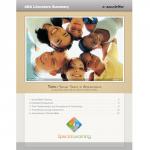Blog Categories
- ADHD
- Applied Behavior Analysis
- Autism Awareness
- Autism Service Providers
- Case Studies
- Dignosis
- Classroom Management
- Credentials
- Ethics
- Family Matters
- FAQs About LIVE Events
- Financial Planning
- Holiday Planning
- IEP's
- Panelists
- Private Equity in Autism & ABA Industry
- Psychopharmacology
- Sensory Processing Disorder
- Speech and Communication
- Subject Matter Experts
- Summer Planning
- Transition Planning
Is my toddler too young for ABA treatment?
schools, and center based programs. She is a Board Certified Behavior Analyst and a previously certified Special Education teacher in Arizona. Along with providing consultation through SBSA, she also currently teaches Positive Behavior Support courses at Northern Arizona University.
Erin is originally from California where she earned her undergraduate degree in Child and Adolescent Studies from California State University, Fullerton. She obtained her master’s degree in Special Education from the University of Phoenix. She completed her coursework in applied behavior analysis from the University of North Texas. She is currently working on her PhD in Psychology at Capella University.
Is my toddler too young for ABA treatment?
Today, many pediatricians administer the Modified Checklist for Autism in Toddlers (M-CHAT) at a toddler’s 15 month or 18 month well-check visit. This practice has helped pediatricians identify toddlers with autism or at risk for autism at a very young age. This allows an opportunity for very early intervention, but what should this intervention look like? Intensive behavior intervention, 1:1 behavioral treatment (ABA therapy), based on applied behavior analysis principles, typically delivered between 20 and 40 hours per week, has been demonstrated effective for children with autism. However, is this too much “work” for a toddler? A common misconception is that ABA therapy forces a child to sit at a table to “work”. When sitting at a table is appropriate, a child may be asked to sit at a table to attend to a task and work towards skills such as receptive language or visual performance. However, the focus of treatment should always be to help the child gain age appropriate skills in which they are deficient. Therefore, a young toddler with autism would “work” on joint attention, pointing to request, pointing to share interest, play appropriately with toys, imitate facial expressions and object manipulation, and interaction with others. This treatment should focus on training in the natural environment. This would look like a provider following the toddler around and taking advantage of the items in the environment the child is interested in. A good example of this can be seen at http://www.youtube.com/watch?v=Da1NkdxivaU.
If a toddler with autism has access to ABA therapy, the therapy will be very beneficial. The following are tips when looking for a provider for your toddler with autism:
1. Carefully consider the provider’s credentials. Someone directing an ABA treatment program should have a certification or licensure in applied behavior analysis.
2. The direct care provider may not be certified or licensed, as long as they are being trained and directed by a certified or licensed individual.
3. Carefully review the treatment plan. Are the goals important to you? Are the goals age appropriate?
4. Ask what treatment will look like. Will the direct care providers work primarily at a table or in the natural environment?







